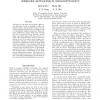Free Online Productivity Tools
i2Speak
i2Symbol
i2OCR
iTex2Img
iWeb2Print
iWeb2Shot
i2Type
iPdf2Split
iPdf2Merge
i2Bopomofo
i2Arabic
i2Style
i2Image
i2PDF
iLatex2Rtf
Sci2ools
AGENTS
1997
Springer
1997
Springer
Adaptation and Learning in Animated Creatures
This paper is concerned with synthetic agents interacting with virtual environments, called animated creatures. The animated creatures are articulated graphical
gures that are equipped with a set of primitive behavioral patterns. These patterns qualitatively specify which body modules will move concurrently, hence forming a motion group, and which group will move prior to another. The parameterization of these patterns is carried out by the creatures given certain external stimuli. The key to such behavioral adaptation lies in an embedded evolution strategy based selection mechanism. Two examples will be given where this selection mechanism enables a bipedal creature and a six-legged creature to dynamically search for the exact positions as well as duration of body joints as constrained by the qualitatively de
ned gait patterns. The acquired new stimulus-response pairs are recorded and inserted into a behavioral conditioning network which can be reused and re
ned during future moveme...
AGENTS 1997 | Animated Creatures | Primitive Behavioral Patterns | Security Privacy | Selection Mechanism |
| Added | 07 Aug 2010 |
| Updated | 07 Aug 2010 |
| Type | Conference |
| Year | 1997 |
| Where | AGENTS |
| Authors | Jiming Liu, Hong Qin, Yuan Yan Tang, Y. T. Wu |
Comments (0)

